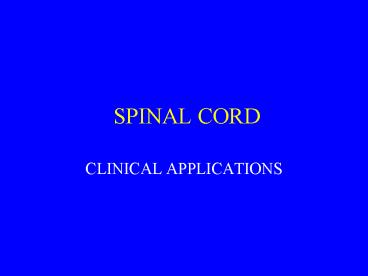SPINAL CORD - PowerPoint PPT Presentation
1 / 22
Title:
SPINAL CORD
Description:
Sensory neurons extend from receptors in skin into spinal cord and end in brain. ... Arachnoid. mater 11. Dura mater 12. Epidural fat. Flexion of Spine for Puncture ... – PowerPoint PPT presentation
Number of Views:54
Avg rating:3.0/5.0
Title: SPINAL CORD
1
SPINAL CORD
- CLINICAL APPLICATIONS
2
NERVE TRACTS
3
Fasciculus cuneatus, gracilis
- Sensory neurons extend from receptors in skin
into spinal cord and end in brain. - Receptors detect movement across skin (velocity),
pressure, and vibration. - Proprioceptors in joints sense position of limbs.
- Gracilis medial from lower levels
- Cuneatus lateral from higher levels
4
Sensory Pathways
F. Cuneatus C2 (most lateral fiber)
F. Cuneatus T6 (most medial fiber)
F. Gracilis T7 (most lateral fiber)
F. Gracilis L5 (most medial fiber)
5
What is the effect of a lesion.
- A lesion in the peripheral spinal nerve prevents
the transfer of information from an entire
dermatome. - A lesion in the spinal cord causes different
effects depending on location, neurons. - Lesion at C1
- Lesion at L3
6
Other lesions in dorsal column.
- Astereognosia, (the inability to recognize
objects or forms by touch.) Put a key in your
hand with your eyes closed and you can identify
it as a key. Agraphesthesia (inability to
recognize letters, numbers, etc., drawn on the
skin). The loss of conscious joint position sense
in the legs (lesion involving fasciculus
gracilis) causes ataxia or incoordination of
gait. Such incoordination results in the
inability of a patient to stand with their feet
together, arms outstretched. This is called a
positive Romberg sign. In the upper extremity,
such ataxia results in clumsiness. Paresthesia
is tingling and numbness resulting from
irritation of the fibers as they die.
7
Spinal Cord Injury
- Recovery from spinal cord injury is fairly
predictable. Persons with a complete injury by
neurologic examination generally are not expected
to make any significant recovery except some
improvement in motor strength in the zone of
injury. Recovery for persons with an incomplete
injury is less predictable and most recovery
occurs within the first six months however, some
additional neurologic recovery may take place up
to 18 months after injury.
8
Spina Bifida
Spina bifida is caused by the failure of the
bones of the spine to fuse during early fetal
development. It occurs with or without the
involvement of the brain, nerves or meninges.
Spina bifida includes deformities of certain
parts of the vertebrae,the spinous process and
vertebral arch.
9
Types of Spina Bifida
10
Spina Bifida Occulta
Since there is no opening to the skin, spina
bifida occulta can only be seen on x-ray or MRI.
Dimpling of the skin or a hairy patch at the
base of the spine may indicate spina bifida.
11
Spina Bifida Occulta
12
Types of Open Spina Bifida
Myelomeningocele
Meningocele
13
Meningocele
14
Myelomeningocele
Marieb and Hoehn, 2007. Human Anatomy
Physiology, Benjamin Cummings.
15
End of Spinal Cord
Location of lumbar puncture an area between the
end of the spinal cord and the end of the dural
sac where a needle can be inserted safely to
withdraw CSF.
16
Lumbar Puncture
17
Transverse Section
- Vertebral artery 2. Vertebral veins 4. 3rd
- cervical spinal ganglion 5.Ventral (anterior)
- median fissure 6. Subdural space 10. Arachnoid
- mater 11. Dura mater 12. Epidural fat
18
Flexion of Spine for Puncture
19
CSF for Lab Analysis
20
REFLEX ARC
21
Peripheral Nerves
22
Peripheral Nerves































